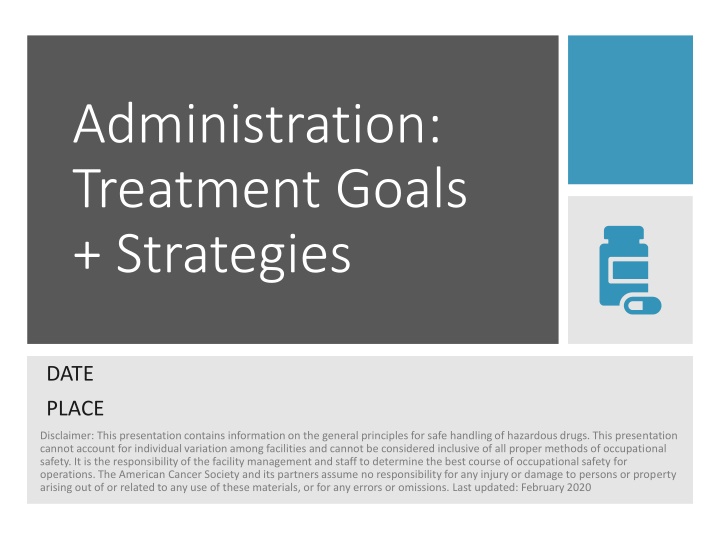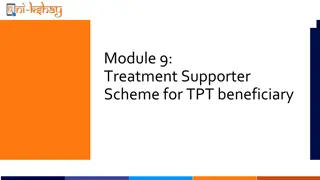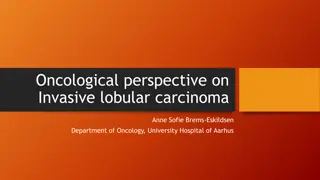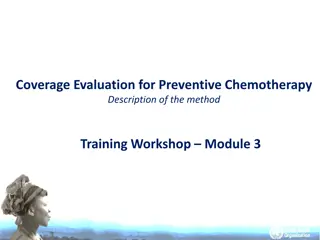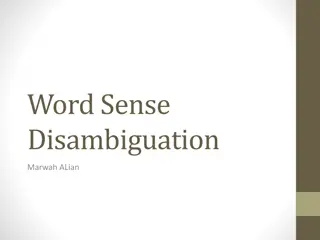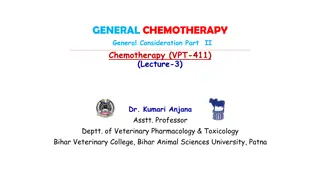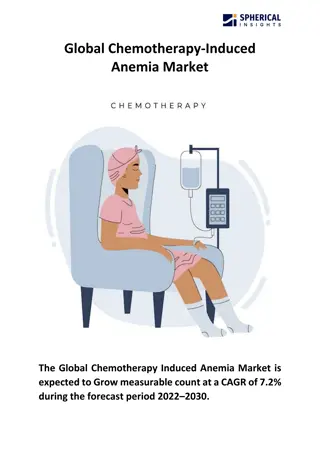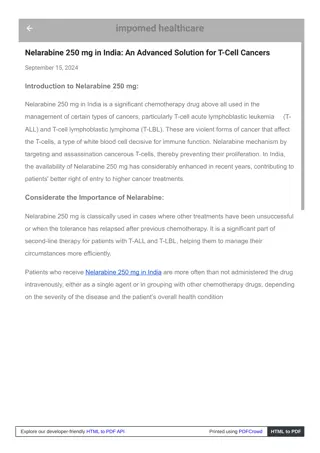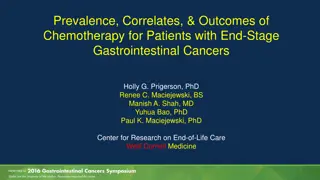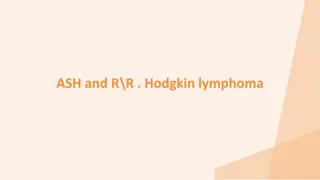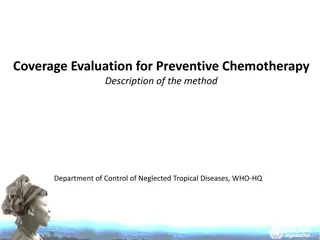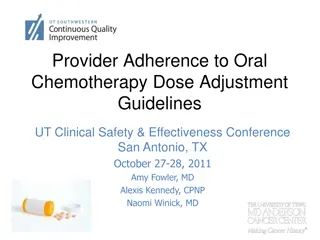Chemotherapy Treatment Approaches and Strategies
In this presentation, learn about treatment goals, strategies, and approaches in chemotherapy administration. Explore neoadjuvant therapy, adjuvant therapy, concurrent chemoradiation, and more. Discover the importance of maintaining the treatment schedule and proper documentation. Ideal for physicians and nurses involved in administering chemotherapy drugs.
Download Presentation

Please find below an Image/Link to download the presentation.
The content on the website is provided AS IS for your information and personal use only. It may not be sold, licensed, or shared on other websites without obtaining consent from the author.If you encounter any issues during the download, it is possible that the publisher has removed the file from their server.
You are allowed to download the files provided on this website for personal or commercial use, subject to the condition that they are used lawfully. All files are the property of their respective owners.
The content on the website is provided AS IS for your information and personal use only. It may not be sold, licensed, or shared on other websites without obtaining consent from the author.
E N D
Presentation Transcript
Administration: Treatment Goals + Strategies DATE PLACE Disclaimer: This presentation contains information on the general principles for safe handling of hazardous drugs. This presentation cannot account for individual variation among facilities and cannot be considered inclusive of all proper methods of occupational safety. It is the responsibility of the facility management and staff to determine the best course of occupational safety for operations. The American Cancer Society and its partners assume no responsibility for any injury or damage to persons or property arising out of or related to any use of these materials, or for any errors or omissions. Last updated: February 2020
Any staff who administer chemotherapy drugs. Who should take this training These staff may include physicians and nurses. 2
Training Modules + Learning Objectives Treatment Approaches Define treatment approaches that utilize chemotherapies. Treatment Dose Calculations Demonstrate the methods of dosing. Explain the sequence of treatment. Identify items that should be included in a treatment order. Explain the verification process of the orders. Treatment Plan Verification 3
Treatment Approaches
Neoadjuvant Therapy Treatment given as a first step to shrink a tumor before the main treatment, usually surgery, is given. Adjuvant Therapy Additional cancer treatment given after the primary treatment to lower the risk that the cancer will come back. Concurrent Chemoradiation Treatment that combines chemotherapy with radiation therapy and is given at the same time. Immunosuppression Suppression of the body's immune system and its ability to fight infections and other diseases. 5 Reference 1
Maintaining the planned treatment schedule is important because systemic cancer treatments often have a narrow margin of therapeutic benefit. Cycle 2 Cycle 1 Cycle 3 6 Reference 4
The treatment plan should be documented on The treatment plan should be documented on the chemotherapy order the chemotherapy order It should include at minimum: Patient s name A second patient identifier The date the order is written Regimen or protocol name and number Cycle number and day, when applicable All medications within the order set listed by using full generic names Drug dose written following standards of abbreviation, trailing zeros, and leading zeros The dose calculation Verification of medication sequence 7 Reference 3 This Photo by Unknown Author is licensed under CC BY-SA-NC
2 Treatment Dose Calculations
Several methods of dosing may be used depending on the prescribed drugs Weight-based dosing Fixed doses Body Surface Area (BSA) based dosing AUC-based dosing 9 Reference 2
Often expressed in milligram (mg) Fixed doses No patient-based calculations are required Verification includes checking if the drugs prescribed fit the appropriate regimen for the type and stage of cancer 10 Reference 2 This Photo by Unknown Author is licensed under CC BY-NC-ND
Weight-based dosing Often expressed as dose of drugs per unit of body weight (e.g. mg/kg) Doses are calculated using the accurate measured weight 11 Reference 2 This Photo by Unknown Author is licensed under CC BY-SA
Often expressed as the total area of a person s skin in square meters (m2) Body Surface Area (BSA) based dosing Current measured height and weight should be used. It should not be estimated or stated by the patient Most commonly used formula is the Mosteller equation ??? ? ?? ?? ? ???? ? ?? ?? 3,600 BSA (m2) = or Be aware of medication- specific circumstances that affect dosing based on BSA ??? ? ?? ??? ?? ? ???? ? ?? ?????? 3,131 BSA (m2) = Reference 2 12
AUC stands for area under the concentration-versus-time curve AUC- based dosing Often used to determine carboplatin doses AUC refers to the amount of drug exposure over time or the total drug concentration in plasma over a period of time 13 Reference 2,6
AUC of carboplatin accounts for: Renal function Age Gender Weight Carboplatin drug clearance is strongly correlated with renal function 14 Reference 2,6 This Photo by Unknown Author is licensed under CC BY-SA
This Photo by Unknown Author is licensed under CC BY-SA-NC Before the AUC can be calculated, the estimated creatinine clearance (estCrCl) needs to be calculated or the actual glomerular filtration rate (GFR) needs to be established. The GFR is rarely used because it requires a 24 hours urine collection. 15 Reference 2,6
There are several formulas to obtain the value of the estCrCl, most commonly used is the Cockcroft-Gault formula. 16 Reference 2
If different formulas are used, the outcomes can show significantly different results. For male patients the Cockcroft-Gault formula is: ??????? (??/???) = 140 ??? ? (???? ? ?? ??) 72 ? ????? ?????????? (??/??) For female patients the Cockcroft-Gault formula is:??????? (??/???) = 140 ??? ? ???? ? ?? ?? ?(0.85) 72 ? ????? ?????????? (??/??) 17 Reference 2
After the estCrCl or GFR are determined, the Calvert formula can be used to calculate the dose of carboplatin. The target AUC is specified in the order. ???? ?? ??????????? ?? = ?????? ??? ? (??????? + ??) 18 Reference 2
The dose calculation should include: The calculation methodology The variables used to calculate the dose The frequency at which the variables are re-evaluated The changes in the values that prompt confirmation of dosing Date of administration Route of administration Allergies Supportive care treatments that are appropriate for the regimen, including premedication, hydration, growth factors, and hypersensitivity medication Parameters that would require holding or modifying dose, for example, laboratory values, diagnostic test results, and patient s clinical status Sequencing of drug administration, when applicable Rate of drug administration when applicable An explanation of time limitation, such as the number of cycles for which the order is valid Reference 3 19
3 Treatment Plan Verification
A licensed pharmacist verifies all orders before administration of chemotherapy A second person a practitioner or other personnel approved to prepare or administer chemotherapy- performs three independent verifications Reference 3 21 This Photo by Unknown Author is licensed under CC BY-SA
Before preparation Before preparation, a second person verifies: Two patient identifiers Drug name Drug dose Route of administration Rate of administration The calculation for dosing Treatment cycle and day of cycle 22 Reference 3
The drug vial(s) Upon Upon preparation preparation, a second person verifies: Concentration Drug volume or weight Diluent type and volume Administration fluid type This Photo by Unknown Author is licensed under CC BY-ND Reference 3 23
Before each chemotherapy Before each chemotherapy administration, at least two administration, at least two practitioners verify and document practitioners verify and document the accuracy of the following the accuracy of the following elements: elements: This Photo by Unknown Author is licensed under CC BY-SA Drug name Drug dose Infusion volume or drug volume when prepared in a syringe Rate of administration Route of administration Expiration dates and/or times Appearance and physical integrity 24 Reference 3
If orders are unclear or leave room for interpretation, clarification needs to be obtained from the prescriber and adequately documented. 25 Reference 2,4
References 1. NCI Dictionary of Cancer Terms [Internet]. National Cancer Institute. [cited 2018 Jun 28]. Polovich M, Olsen M, LeFebvre K. Chemotherapy and biotherapy guidelines and recommendations for practice. 4th ed. Oncology Nursing Society; 2014. Neuss MN, Gilmore TR, Belderson KM, Billett AL, Conti-Kalchik T, Harvey BE, et al. 2016 Updated American Society of Clinical Oncology/Oncology Nursing Society Chemotherapy Administration Safety Standards, Including Standards for Pediatric Oncology. J Oncol Pract. 2016 Dec;12(12):1262 71. Levine. Chemotherapy (in J.Eggert (ed.), Cancer Basics. Pittsburgh: Oncology Nursing Society; pp. 195-215. Kouno T, Katsumata N, Mukai H, Ando M, Watanabe T. Standardization of the body surface area (BSA) formula to calculate the dose of anticancer agents in Japan. Jpn J Clin Oncol. 2003 Jun;33(6):309 13. Creatinine Clearance Estimate by Cockcroft-Gault Equation Calculator [Internet]. [cited 2018 Jul 19]. 2. 3. 4. 5. 6. 26
